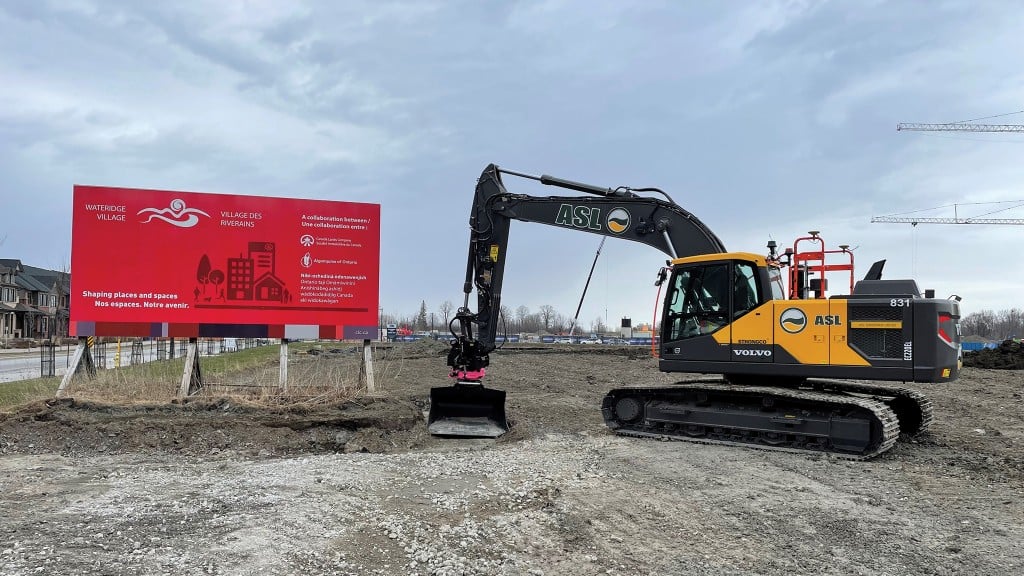ASL leverages machine control data for real-time insight into field operations
Data-driven construction environment saves Canadian contractor time and money

ASL, based in Osgoode, Ontario, embraces new technology that can give its business a competitive edge in bidding, time management, and profitability. This long-serving mid-size Ontario contractor was an early user of tiltrotators and machine control and now, under the stewardship of young leaders, exemplifies how to use the latest construction technology tools to deliver managers complete as-built visibility into field operations in real time – and they have achieved this with limited personnel resources.
ASL evolves from tile drainage to mass earthmoving
Founded by John Wielgut in 1975, Agrodrain Systems Limited took an unusual route to the 200+ employee contractor that it is today. Wielgut started as an agricultural drainage contractor servicing the local farming community in the greater Ottawa region, putting in tile drainage to improve crop yields; in the 1980s he took his drainage solutions to farmers in India and Pakistan. When he returned to Canada, he developed a customized trencher for putting in gas lines, and later got into golf course construction in both the U.S. and Canada before moving into mass earthworks, which remains the core of ASL's business today.
The company now focuses on horizontal integration, offering full-project services for everything outside the building footprint up to top of concrete. ASL partners with developers to operate in six sectors: residential development, civil works, site development, concrete, landscaping, and, more recently, geothermal drilling. Tasks include knocking down trees, digging ponds, putting pipe in the ground, excavation and backfill, forming concrete, and building parks.
Young leadership pushes innovation at ASL
Sandro Ricci, president, and Cody Morgan, project manager, have been with ASL since 2012.
Ricci was trained as an engineer and worked for large consulting firms Stantec and Worley in Vancouver before moving to Ottawa, seeking a bigger role at a smaller company and experience on the contractor side of construction. As Ricci puts it, "Consultants run away from risk that contractors run to," and he appreciates the risk in the contracting business.
At ASL, Ricci worked his way up from project manager, to VP, to president while completing an MBA in 2019 to gain a business background. He notes the value of his involvement with the Young Presidents Organization (YPO), the largest organization of CEOs in the world. This peer group has been instrumental to both his career and growing and running ASL.
Morgan worked at ASL during summers while studying civil engineering and, after his fourth summer, joined the company full time as a project coordinator under Ricci. After gaining experience on the job site as a foreman, Morgan developed an interest in working more in the office as a project manager; Ricci made him a junior project manager. After Ricci became president, Morgan moved into the role of project manager and, just recently, innovation manager.
Today, Ricci's passion for leading a company that is forward-thinking – he considers ASL a data-driven company in a non-data-driven industry – is clear. This is a company hyper-focused on efficiency and empowering its employees to do great work by setting them up with the right tools. This requires taking a field-first approach to technology adoption, which needs buy-in from operators and managers.
As Ricci notes, the key to getting everyone on board is to demonstrate the benefits of the new technology before asking employees to learn it. "If you're going to ask someone to do something, you have to take something away, or give information enabling them to do their work better," he says.
Outside-the-box thinking frees up valuable labour resources
Ricci and Morgan dispel the notion that deploying software to automate construction business processes is time and resource intensive. They have developed an in-house database, The Hub, without in-house IT.
While working with a local college grad, who had been hired to on-board scheduling software, Ricci recognized that the developer's strength was in building databases; he worked with the developer to create an invoicing database. Both Ricci and Morgan had spent long hours as project managers invoicing stone. The Hub eliminates much of this work by pushing stone tickets to project managers with a follow-up if the invoice hasn't been sent. The company saw huge ROI in terms of cash flow – invoices no longer fell through the cracks.
ASL builds on early adoption of machine control
ASL's early adoption of machine control allows the company to leverage data they were already collecting to transform it into deeper insight taking efficiency gains to the next level. Machine control, 2D and 3D, expedites work for the operator, whether they're digging a trench or creating a slope profile. But these systems do more than make the operator's job easier – they capture data that can deliver a contractor value beyond completing the task.
To send 3D models and information between the office and the field, ASL uses Trimble Business Center, WorksManager, and WorksOS. Operators follow the models, and the data from their machines goes back to the office via the cloud where, using internal databases, Microsoft Power BI, and Trimble dashboards, information on the work is pushed to managers in real time.
"The goal is to understand that you did the work correctly and, if not, what is incorrect and how big of a problem that is - begging the question, what are you going to do to fix it?" says Morgan. This as-built reporting gives ASL managers the confidence that their projects are on track and on budget – they know within seconds if work is being done incorrectly. With old accounting, there could potentially be a 30- or 60-day lag before the company knew if it had made money. Now they know in real time.
This comprehensive, accurate information translates into greater accuracy in bidding processes for future projects, avoiding the cost creep that comes from unnecessary re-work and less precise estimations. ASL also has greater control over the schedule when re-work is eliminated.
Clients benefit from real-time insight into the process, too. If a change to design needs to be made, it can be anticipated and approvals can be sent to the client in real time, rather than weeks or months later.
ASL required minimal consulting from Microsoft and Trimble and minimal in-house and external resources to set up these new processes and integrate the Microsoft and Trimble solutions – Morgan worked with a programmer to set up the company's Microsoft Azure database.
For its next phase, ASL plans to adopt exception-based reporting via Microsoft's Azure cloud computing platform.
Morgan explains, "The idea there is to set tolerances and anytime we see the work is exceeding tolerance, that's what you need to look at. We'll have Microsoft through Azure sending out those reports, and only reports that do not meet the tolerance are going to be sent to the management team. The idea is that they can focus their energy and correct those actions."
Real-time validation for operators and managers
ASL employees see their work validated in real time which gives them the confidence to move on to the next task knowing that the job is done correctly and won't require re-work. But there are other benefits as well.
Automating processes enables managers to review far more job sites in a day – where one person could get to three sites under the old system, with the new automation and reporting processes, that one employee can now review 30 sites.
Ricci adds that adopting new technology attracts and retains workers when those workers understand that the company is trying to make their jobs easier.
When ASL invests in new innovations, whether it's tiltrotators, machine control, or databases, it's based on operational needs to make field staff more efficient so that they spend more time making the company money and less time pushing paper.
"Our vision is to be the most technologically advanced construction company in our market," says Ricci. "Everybody in the company will get the information that they need when they need it, and it will be right." HEG
ASL is supported by Trimble and SITECH Eastern Canada
Trimble's regional dealer, SITECH Eastern Canada, makes sure that ASL's Trimble solutions that provide data are working correctly and that ASL users have the skills to operate efficiently.
ASL embraces Trimble solutions
Trimble Earthworks
Trimble Earthworks is designed to help you do more in less time. Reengineered from the ground up, the innovative, next generation grade control platform features intuitive, easy-to-learn software that runs on an Android operating system. State-of-the-art software and hardware give operators of all skill levels the ability to work faster and more productively than ever before.
Trimble Business Center
With Trimble Business Center you can manage data across the whole project life cycle by using combined survey and earthwork data. Efficiently calculate earthwork and material quantities for bids, prepare data for construction stakeout, build 3D models to optimize machine operation, track productivity, and deliver as-built documentation.
Trimble WorksOS
Created for site supervisors and project managers, WorksOS provides critical project information straight from the machine including real-time cut, fill, volume, and compaction data. Progress for each project can be viewed in a single dashboard, and you can accurately calculate the productivity of each construction asset and associate it to direct project costs.
Trimble WorksManager
Troubleshoot issues in the field, know where your machines and survey crews are and what designs they are working on, and support the team from the office all via automatic data transfer that keeps you connected to the job site. With WorksManager you can remotely send construction-ready models to machines and survey crews in the field and manage technology assets across job sites.




